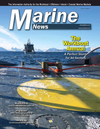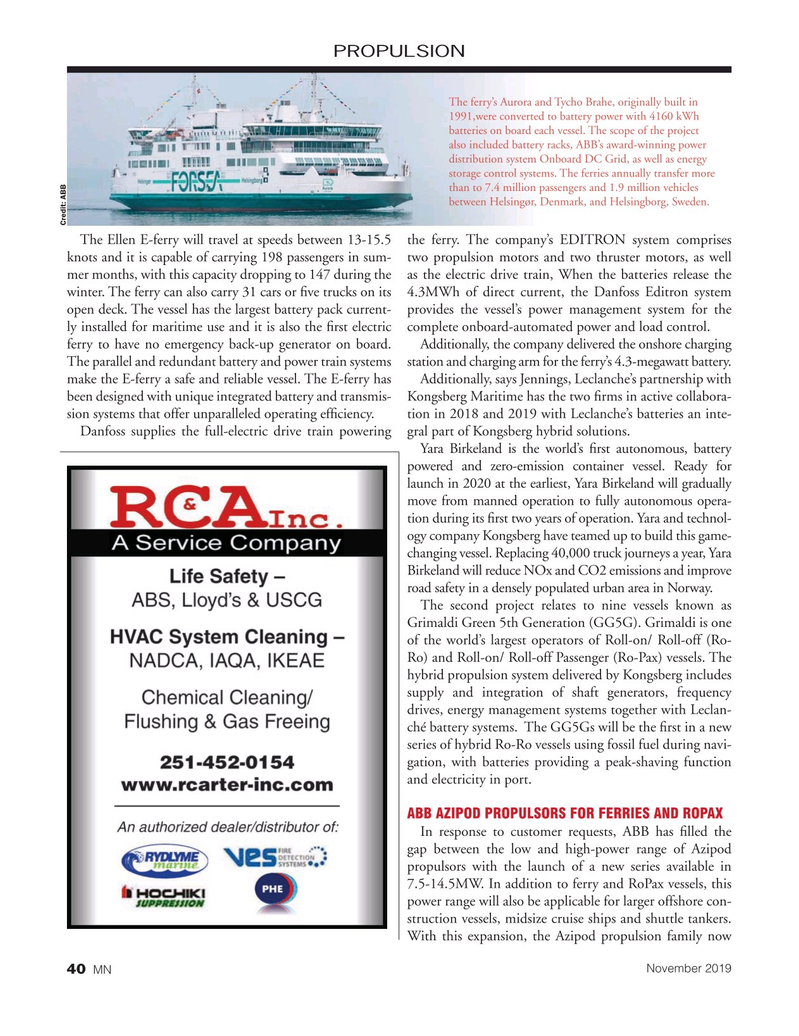
Page 40: of Marine News Magazine (November 2019)
Workboat Annual
Read this page in Pdf, Flash or Html5 edition of November 2019 Marine News Magazine
PROPULSION
The ferry’s Aurora and Tycho Brahe, originally built in 1991,were converted to battery power with 4160 kWh batteries on board each vessel. The scope of the project also included battery racks, ABB’s award-winning power distribution system Onboard DC Grid, as well as energy storage control systems. The ferries annually transfer more than to 7.4 million passengers and 1.9 million vehicles between Helsingør, Denmark, and Helsingborg, Sweden.
Credit: ABB
The Ellen E-ferry will travel at speeds between 13-15.5 the ferry. The company’s EDITRON system comprises knots and it is capable of carrying 198 passengers in sum- two propulsion motors and two thruster motors, as well mer months, with this capacity dropping to 147 during the as the electric drive train, When the batteries release the winter. The ferry can also carry 31 cars or ? ve trucks on its 4.3MWh of direct current, the Danfoss Editron system open deck. The vessel has the largest battery pack current- provides the vessel’s power management system for the ly installed for maritime use and it is also the ? rst electric complete onboard-automated power and load control. ferry to have no emergency back-up generator on board. Additionally, the company delivered the onshore charging
The parallel and redundant battery and power train systems station and charging arm for the ferry’s 4.3-megawatt battery.
make the E-ferry a safe and reliable vessel. The E-ferry has Additionally, says Jennings, Leclanche’s partnership with been designed with unique integrated battery and transmis- Kongsberg Maritime has the two ? rms in active collabora- sion systems that offer unparalleled operating ef? ciency. tion in 2018 and 2019 with Leclanche’s batteries an inte-
Danfoss supplies the full-electric drive train powering gral part of Kongsberg hybrid solutions.
Yara Birkeland is the world’s ? rst autonomous, battery powered and zero-emission container vessel. Ready for launch in 2020 at the earliest, Yara Birkeland will gradually move from manned operation to fully autonomous opera- tion during its ? rst two years of operation. Yara and technol- ogy company Kongsberg have teamed up to build this game- changing vessel. Replacing 40,000 truck journeys a year, Yara
Birkeland will reduce NOx and CO2 emissions and improve road safety in a densely populated urban area in Norway.
The second project relates to nine vessels known as
Grimaldi Green 5th Generation (GG5G). Grimaldi is one of the world’s largest operators of Roll-on/ Roll-off (Ro-
Ro) and Roll-on/ Roll-off Passenger (Ro-Pax) vessels. The hybrid propulsion system delivered by Kongsberg includes supply and integration of shaft generators, frequency drives, energy management systems together with Leclan- ché battery systems. The GG5Gs will be the ? rst in a new series of hybrid Ro-Ro vessels using fossil fuel during navi- gation, with batteries providing a peak-shaving function and electricity in port.
ABB AZIPOD PROPULSORS FOR FERRIES AND ROPAX
In response to customer requests, ABB has ? lled the gap between the low and high-power range of Azipod propulsors with the launch of a new series available in 7.5-14.5MW. In addition to ferry and RoPax vessels, this power range will also be applicable for larger offshore con- struction vessels, midsize cruise ships and shuttle tankers.
With this expansion, the Azipod propulsion family now
November 2019 40 MN
MN Nov19 Layout 32-49.indd 40 MN Nov19 Layout 32-49.indd 40 10/28/2019 3:08:19 PM10/28/2019 3:08:19 PM

 39
39

 41
41
